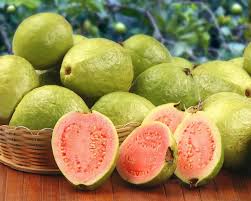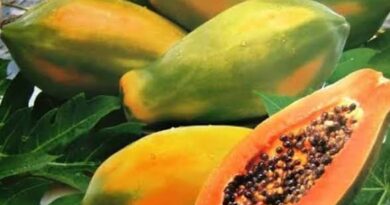Guavas: History, Nutrition, Health Benefits and Growing Guide
Guavas scientifically known as Psidium guajava are delightful fruits with a sweet and unique taste. These tropical wonders come in various colors, such as green, yellow, or pink, and their soft, fragrant flesh is filled with tiny seeds. Guavas are not only delicious but also pack a nutritional punch.
In terms of health benefits, guavas are rich in vitamin C, which is essential for a strong immune system. Regular consumption of guavas can help protect against common illnesses like colds and flu. Additionally, guavas contain dietary fiber, aiding in digestion and promoting a healthy gut.
One fascinating aspect of guavas is their versatility. Whether eaten fresh, juiced, or included in various recipes, guavas can enhance the flavor profile of many dishes. From jams and jellies to smoothies and desserts, the possibilities are endless.
Cultivating guavas is relatively easy, as these fruits thrive in warm climates. They require well-drained soil and regular watering to flourish. Guava trees are known for their resilience and ability to withstand different weather conditions, making them a favorite among fruit growers.
Beyond their nutritional value, guavas have cultural significance in various regions. They are often included in traditional cuisines and celebrations. The sweet aroma of ripe guavas is not only inviting but also adds a pleasant touch to the ambiance.
Guavas also play a role in natural remedies. Some believe that guava leaves have medicinal properties and can be used for treating ailments like diarrhea and skin problems. The leaves are often brewed into a tea, providing a soothing and natural remedy.
Whether enjoyed fresh on a sunny day or incorporated into culinary creations, guavas offer a burst of tropical flavor. From their health benefits to cultural importance, these fruits have earned their place as a beloved and versatile addition to the world of fruits. Guavas truly stand out as a delightful gift from nature, bringing joy and goodness to those who savor their delicious essence.
Read Also: Fowl Cholera Disease and Methods of Treatment
The History of Guavas (Psidium guajava)

The history of guavas is intertwined with the rich tapestry of tropical regions, where these delectable fruits have thrived for centuries. Native to Central America and parts of South America, guavas have a long and storied past.
Originally cultivated by indigenous peoples in the Americas, guavas were discovered by early explorers, including Christopher Columbus, during their voyages in the 15th and 16th centuries. The fruit’s appeal and unique taste quickly captivated the palates of explorers, leading to its introduction to other parts of the world.
In the subsequent centuries, guavas found their way to various tropical and subtropical regions, adapting to different climates and soil conditions. This adaptability contributed to the widespread cultivation of guava trees across Asia, Africa, and the Caribbean.
Guavas played a crucial role in local diets and traditional medicine. Native communities valued the fruit not only for its flavor but also for its medicinal properties. The leaves, in particular, were used for their perceived health benefits, such as treating digestive issues and skin ailments.
The colonial era saw guavas becoming a part of global trade and commerce. European colonizers recognized the economic potential of guavas and actively promoted their cultivation in colonies with suitable climates. This widespread cultivation further solidified guavas as a staple fruit in many regions.
As time progressed, guavas gained popularity not only for their taste but also for their nutritional content. Rich in vitamin C and dietary fiber, guavas became recognized for their contribution to a healthy diet.
Today, guavas are enjoyed worldwide, with various cultivars and species available. Their journey from the rainforests of Central and South America to becoming a global fruit staple is a testament to the resilience and adaptability of guava trees and the enduring appeal of these tropical delights.
Nutritional Value of Guava (Psidium guajava)

Guavas boast a remarkable nutritional profile, making them a wholesome addition to a balanced diet. These tropical fruits are not only delicious but also offer a range of essential nutrients that contribute to overall health.
First and foremost, guavas are exceptionally rich in vitamin C. Just a single guava can provide a substantial portion of the daily recommended intake of this vital nutrient. Vitamin C is known for its immune-boosting properties, helping the body defend against infections and supporting collagen formation for healthy skin.
Dietary fiber is another standout feature of guavas. The fiber content aids in digestion, promoting a healthy gut and preventing constipation. Consuming guavas as part of a fiber-rich diet may also contribute to weight management and heart health.
Guavas contain various antioxidants, including lycopene and beta-carotene. These compounds have been associated with reducing the risk of chronic diseases and promoting eye health. Lycopene, in particular, is known for its potential in protecting against certain types of cancers.
The fruit is a good source of several essential minerals, such as potassium, magnesium, and manganese. Potassium is crucial for maintaining healthy blood pressure levels, while magnesium plays a role in muscle and nerve function. Manganese contributes to the body’s antioxidant defenses.
While guavas are relatively low in calories, they provide a natural sweetness, making them a satisfying and nutritious snack. The combination of vitamins, minerals, and antioxidants in guavas makes them a valuable addition to a diverse and health-conscious diet.
In addition, guavas offer a plethora of nutritional benefits, from immune support and digestive health to antioxidants and essential minerals. Including guavas in your diet not only adds a burst of tropical flavor but also provides a nutritious boost for overall well-being.
Read Also: Poultry Farming and Adverse Season as a Stressor
Health Benefits of Guava (Psidium guajava)

Guavas are a nutritional powerhouse, offering a range of health benefits that contribute to overall well-being. Here are some key advantages associated with the consumption of guavas:
1. Immune System Boost: Guavas are exceptionally high in vitamin C, a potent antioxidant that plays a crucial role in supporting the immune system. Regular intake of vitamin C from guavas may help the body defend against infections and illnesses.
2. Digestive Health: The dietary fiber content in guavas promotes healthy digestion and helps prevent constipation. The fiber also supports a balanced gut microbiome, contributing to overall digestive well-being.
3. Heart Health: Guavas contain potassium, a mineral that helps regulate blood pressure. The potassium content, combined with the fiber and antioxidants, contributes to heart health by supporting normal blood pressure levels and reducing the risk of cardiovascular issues.
4. Weight Management: Guavas are low in calories and high in fiber, making them a satisfying and nutritious snack. Including guavas in a balanced diet may aid in weight management by promoting a feeling of fullness and reducing overall calorie intake.
5. Eye Health: The presence of antioxidants like lycopene and beta-carotene in guavas has been linked to a reduced risk of age-related macular degeneration (AMD) and other eye conditions. These compounds contribute to maintaining good vision.
6. Skin Health: Vitamin C is essential for the synthesis of collagen, a protein that supports skin structure. Guavas, with their high vitamin C content, may contribute to healthier and more radiant skin.
7. Cancer Prevention: The antioxidants found in guavas, including lycopene and quercetin, have been studied for their potential in preventing certain types of cancers. While more research is needed, including guavas in a diet rich in antioxidants may have protective effects.
8. Blood Sugar Regulation: Some studies suggest that guavas may help regulate blood sugar levels, making them a potentially beneficial fruit for individuals with diabetes. The fiber content and low glycemic index contribute to this effect.
Incorporating guavas into your diet can be a delicious and nutritious way to support various aspects of your health. However, it’s essential to maintain a well-balanced diet and a healthy lifestyle for overall well-being.
How to Grow Guava (Psidium guajava)
Growing guavas can be a rewarding experience, and these tropical fruits thrive in warm climates. Here’s a general guide on how to grow guavas:
1. Selecting a Variety: Choose a guava variety that suits your climate. Common varieties include common guava (Psidium guajava), strawberry guava (Psidium cattleianum), and pineapple guava (Feijoa sellowiana).
2. Climate and Location: Guavas prefer tropical or subtropical climates. They thrive in full sunlight but can tolerate partial shade.
Ensure the location has well-drained soil to prevent waterlogging, as guava roots are sensitive to waterlogged conditions.
3. Soil Preparation: Guavas prefer slightly acidic to neutral soil with a pH between 5.5 and 7.0. Incorporate organic matter, such as compost, into the soil to enhance fertility.
4. Planting: Plant guava seeds or young seedlings in the prepared soil.
Dig a hole large enough to accommodate the root ball. Space guava trees about 10 to 15 feet apart, as they can grow into medium-sized trees.
5. Watering: Guavas require regular watering, especially during dry periods. However, they are sensitive to waterlogged conditions, so ensure proper drainage. Young plants may need more frequent watering until established.
6. Fertilizing: Fertilize guava trees regularly with a balanced, slow-release fertilizer.
Apply fertilizer in spring and early summer to support healthy growth.
7. Pruning: Prune guava trees to shape them and remove dead or crowded branches.
Regular pruning can help improve air circulation and sunlight penetration.
8. Pest and Disease Control: Keep an eye out for common pests like aphids, scales, and whiteflies. Use natural or chemical methods to control pests. Guavas can be susceptible to diseases like anthracnose and root rot. Proper watering and well-drained soil can help prevent these issues.
9. Harvesting: Guavas typically start producing fruit within 2 to 4 years after planting.
Harvest ripe guavas when they have a pleasant fragrance and yield slightly to gentle pressure.
10. Propagation: Guavas can be propagated through seeds, cuttings, or grafting.
Seed propagation is common, but it may take longer to produce fruit compared to other methods.
Remember that specific care requirements may vary depending on the guava variety and local climate. Always consider local conditions and consult with local gardening experts for tailored advice.
Read Also: Complete Composting Guide for Beginners









